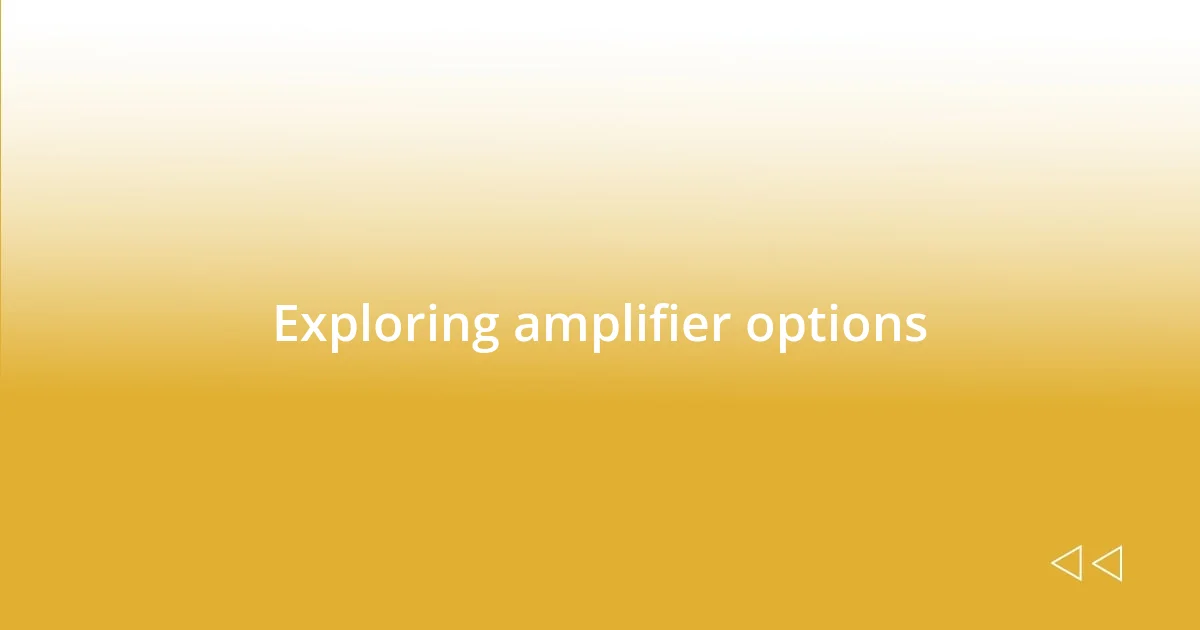Key takeaways:
- Understanding guitar tone is a multi-faceted journey, influenced by guitar type, pickups, amp settings, strings, and playing technique.
- Choosing the right guitar involves personal preferences regarding body type, wood, pickups, and neck profile, all of which affect overall tone.
- Experimenting with gear—including amplifiers and pedals—allows for creative sound shaping, emphasizing the importance of personal exploration and fine-tuning settings.

Understanding guitar tone basics
To truly grasp guitar tone, it’s essential to understand that tone isn’t just a one-dimensional characteristic; it’s a combination of factors like your guitar type, pickups, and even your playing style. I remember the first time I switched from single-coil to humbucker pickups; it felt like unveiling a totally new layer of sound. Have you ever experienced that moment when you hit a chord and just knew it was right?
The settings on your amp play a pivotal role too. I often found myself tangled in endless tweaks, trying to balance treble and bass until I finally realized the sweet spot for my sound. It’s funny how just a slight adjustment can transform your tone; that’s when it hit me—tone shaping is an adventure and requires some trial and error.
Lastly, let’s not forget the importance of the strings and your technique. I find that fresh strings can deliver a brightness that fades over time, and I’ve learned to change them regularly. How do your fingers dance on the fretboard? Your playing dynamics—the way you strike the strings—can reveal a depth to your tone that’s simply magical. Each tiny component works together, creating a sound that is uniquely yours.

Choosing the right guitar
Choosing the right guitar is a personal journey, one that can feel overwhelming at first. When I picked up my first electric guitar, I was captivated by its sleek design but soon realized that the sound it produced didn’t quite match my musical aspirations. It took me some time to understand how the body shape, wood type, and even the neck length can dramatically influence the overall tone.
Here are some key factors to consider when selecting your guitar:
- Body Type: Different shapes (solid, hollow, semi-hollow) resonate uniquely. The first time I strummed an acoustic dreadnought, I felt the vibrations deeply, and it inspired my songwriting immediately.
- Pickups: Consider between single-coil and humbucker. Switching pickups changed my sound palette, allowing me to explore genres I hadn’t before.
- Wood Type: Each wood imparts distinct acoustic properties; a mahogany body can yield a warm tone, while maple adds brightness.
- Neck Profile: The comfort of your fretting hand is essential. I struggled initially with thicker necks, but finding a slimmer profile felt like putting on a favorite pair of shoes.
- String Action: Low action offers easier playability, but watch out for fret buzz. I’ve spent hours adjusting the truss rod to find that sweet spot.
Every detail matters, and I often think back to my own discovery process. You really can’t rush finding the right match for you. It’s not just a tool; it becomes an extension of your musical self.

Selecting essential guitar gear
Selecting the right gear can significantly impact your guitar tone, and it can be quite a journey to find what works best for you. I still remember the excitement of trying out my first pedal; it opened up a whole new realm of sounds that I never thought I could achieve. Pedals can range from overdrives to delays, each adding its flavor to the signal chain. Have you ever stepped on a switch and felt your sound transform instantly? That feeling is what drives so many of us to experiment.
Then there’s the amplifier, which often feels like the heart of your sonic setup. I once had a cheap practice amp that lacked character, but after investing in a quality tube amp, I noticed an incredible warmth and depth in my tone. My playing truly blossomed as I started to explore its settings. It’s fascinating how different amp types—like solid state versus tube—can create distinctly different sounds; knowing what resonates with you is essential.
To help you navigate the myriad options in guitar gear, here’s a comparison of essential components to consider in your setup:
| Gear Type | Key Characteristics |
|---|---|
| Guitar | Body type influences resonance; type of wood impacts clarity and warmth. |
| Amplifier | Tube amps deliver warmth; solid-state amps offer reliability and clean tone. |
| Pedals | Variety of effects to enhance sound; distortion vs. modulation greatly alters tone. |
| Strings | Gauge and material affect playability and tone brightness; regular changes maintain sound quality. |

Exploring amplifier options
Finding the right amplifier can be a pivotal part of shaping your guitar tone. I have vivid memories of spending hours in music stores, plugging my guitar into various amps and feeling the excitement build as I discovered different sounds. Have you ever noticed how a single twist of a tone knob can completely transform your sound? It’s moments like that which fuel my passion for refining my rig.
As I delved deeper into the world of amplifiers, I learned the distinct characteristics of tube versus solid-state amps. My first tube amp was a game-changer; when I cranked it up, the warmth and sustain made me feel like I was truly in the moment, creating music that resonated with my soul. On the other hand, I appreciated the reliability of solid-state amps during live gigs, where you need a dependable sound that can withstand the unpredictability of a crowded venue.
I also found that utilizing an amp’s features, like EQ settings and built-in effects, expanded my creative possibilities. Experimenting with those knobs—sometimes cautiously, sometimes boldly—felt like finding a hidden treasure trove of tones. It raised the question for me: How much tone shaping can you really achieve with just one amp? The answer, I’ve discovered, is quite a lot! Each adjustment not only enhances your personal sound but also inspires new ways to express yourself musically.

Experimenting with effects pedals
Experimenting with effects pedals has been one of the most enjoyable aspects of my guitar journey. Each pedal feels like a new adventure waiting to unfold. I recall the day I plugged in my first delay pedal—suddenly, my simple riffs turned into cascading echoes that seemed to stretch into infinity. Have you ever heard your favorite song transformed by a pedal? At that moment, I realized the possibilities of sound were endless.
As I explored the diverse world of effects—everything from reverb to fuzz—I found myself drawn to how each pedal enhanced different elements of my playing. One day, I paired a distortion pedal with my clean tone, and the result was mind-blowing; it was as if I had unleashed a hidden power within my guitar. Each session became a deep dive into experimentation, with an array of settings allowing me to sculpt my perfect tone. It’s thrilling to discover how even minute adjustments can result in vastly different sounds, sparking a whole new level of creativity in my playing.
There were times I felt overwhelmed by the sheer number of options. In those moments, I learned that sometimes less is more. For instance, I pared down my pedal board to just a few essentials—an overdrive, a chorus, and a delay. This minimalist approach not only made my setup more manageable but also forced me to focus on how to utilize each pedal effectively. I found that experimenting with a fewer number of effects can lead to deeper understanding and discovery. Have you ever simplified your approach and found new inspiration? I certainly have, and it has shaped my tonal exploration in surprising ways.

Fine-tuning your tone settings
Fine-tuning your tone settings is where the magic truly happens, and I must admit, it often felt like a personal journey through trial and error. I remember spending an entire afternoon dialing in my EQ settings to achieve that ‘just right’ sound. With every slight adjustment, I felt a rush—like unearthing a secret layer to my music. Have you ever turned a knob and felt an instant connection with the new tone it evokes? It’s those little victories that keep us motivated.
One of the biggest revelations came when I learned to embrace the nuances between different settings, particularly the midrange and treble. I’ll never forget the day I decided to boost my mids just a notch. Suddenly, my solos came alive with a presence I hadn’t noticed before, cutting through the mix with clarity and depth. It made me wonder: how often do we overlook the simplest tweaks that can lead to profound changes in our sound? Tuning into those frequencies unlocked a whole new dimension in my playing.
Sometimes, the key to fine-tuning lies in harmonizing your tone settings with the context of the music you’re playing. I had a breakthrough moment while rehearsing with my band for an upcoming gig. After adjusting my settings to fit the acoustics of the venue, I felt like I truly found my voice within the band. When the sound clicked, it became clear that what works in isolation might need to shift slightly in a full band context. Doesn’t it make you curious how much tweaking can influence overall performance? I’ve learned that exploring tone settings is not just about the gear; it’s about the connection we build with our instrument and each other.

Capturing your perfect tone
Capturing your perfect tone feels like embarking on a treasure hunt, with every note you play guiding you closer to the sound you’ve always envisioned. I distinctly remember a night spent with my amp in a dimly lit room—just me, my guitar, and hours of experimenting. Striking the right chord with all the settings, I suddenly hit a tone that made me stop in my tracks. Have you ever experienced that exhilarating moment when the sound resonates deep within you? It was as if the universe aligned, and I could finally hear the sound that had been swirling in my mind.
I often find that inspiration can come from the unlikeliest of places. Recently, I decided to set my guitar down and just listen—to the music around me, to the tones other musicians were achieving. It hit me that tone isn’t just about equipment; it’s about context and intention. Wearing headphones, I closed my eyes and imagined how the guitar parts I love would sound if I infused my personality into them. That’s when I began to see my tone not just as a sound, but as an emotional expression, a reflection of who I am. Isn’t it fascinating how different environments can shape our understanding of tone? I’ve learned that sometimes, stepping back can offer fresh insights.
The process of capturing your perfect tone is ongoing—it involves listening, adjusting, and feeling. I vividly remember a practice session where, with each note, my instinct screamed that something was off. After adjusting my pedal chain, the change was immediate; I felt lighter and more connected to my sound. Have you experienced that euphoric moment when the right combination of tones and your playing style come into harmony? It’s indescribable, a reminder of why we embrace this journey in the first place. Each adjustment, each moment of clarity, draws me closer to the musician I aspire to be.















